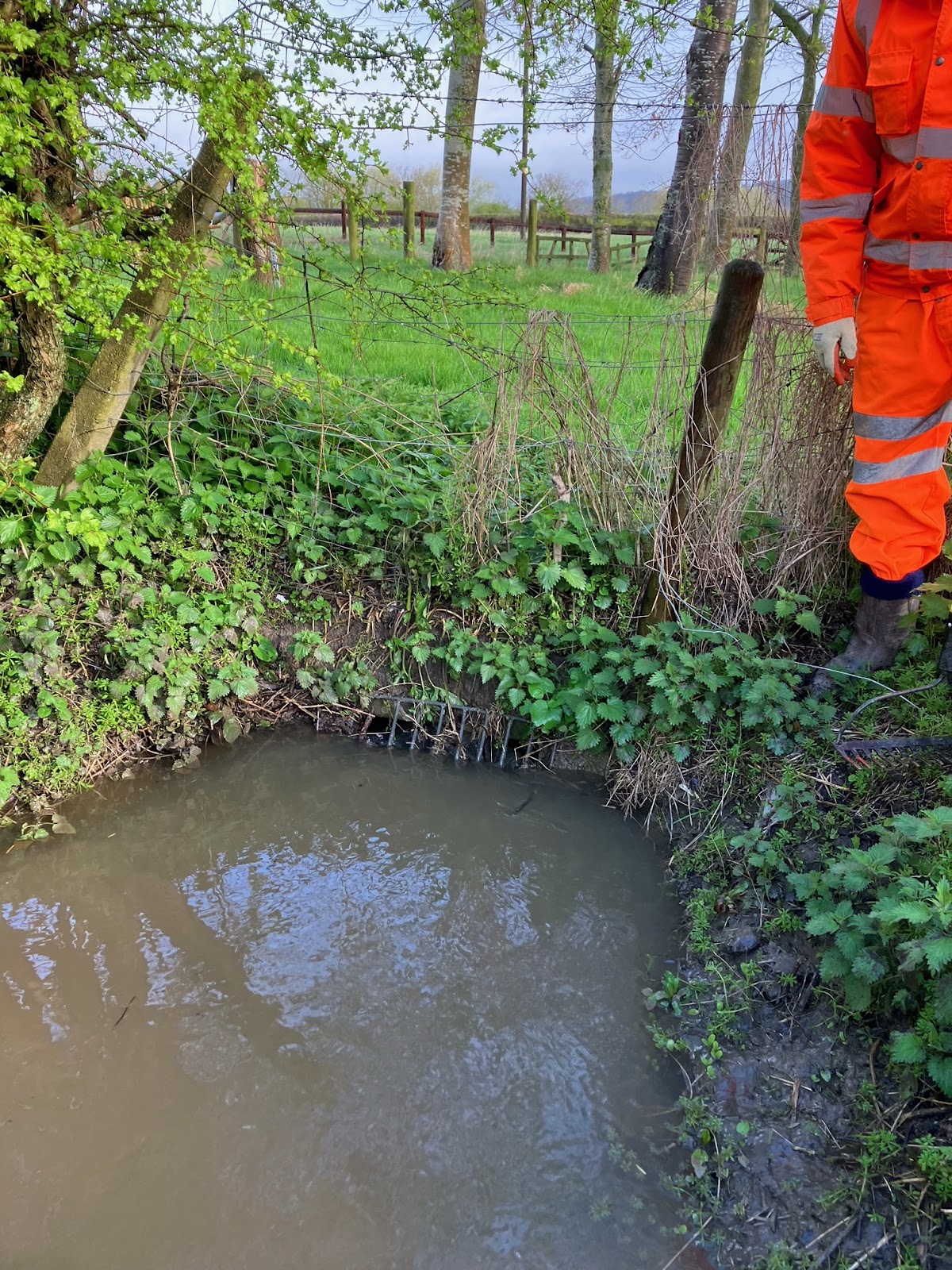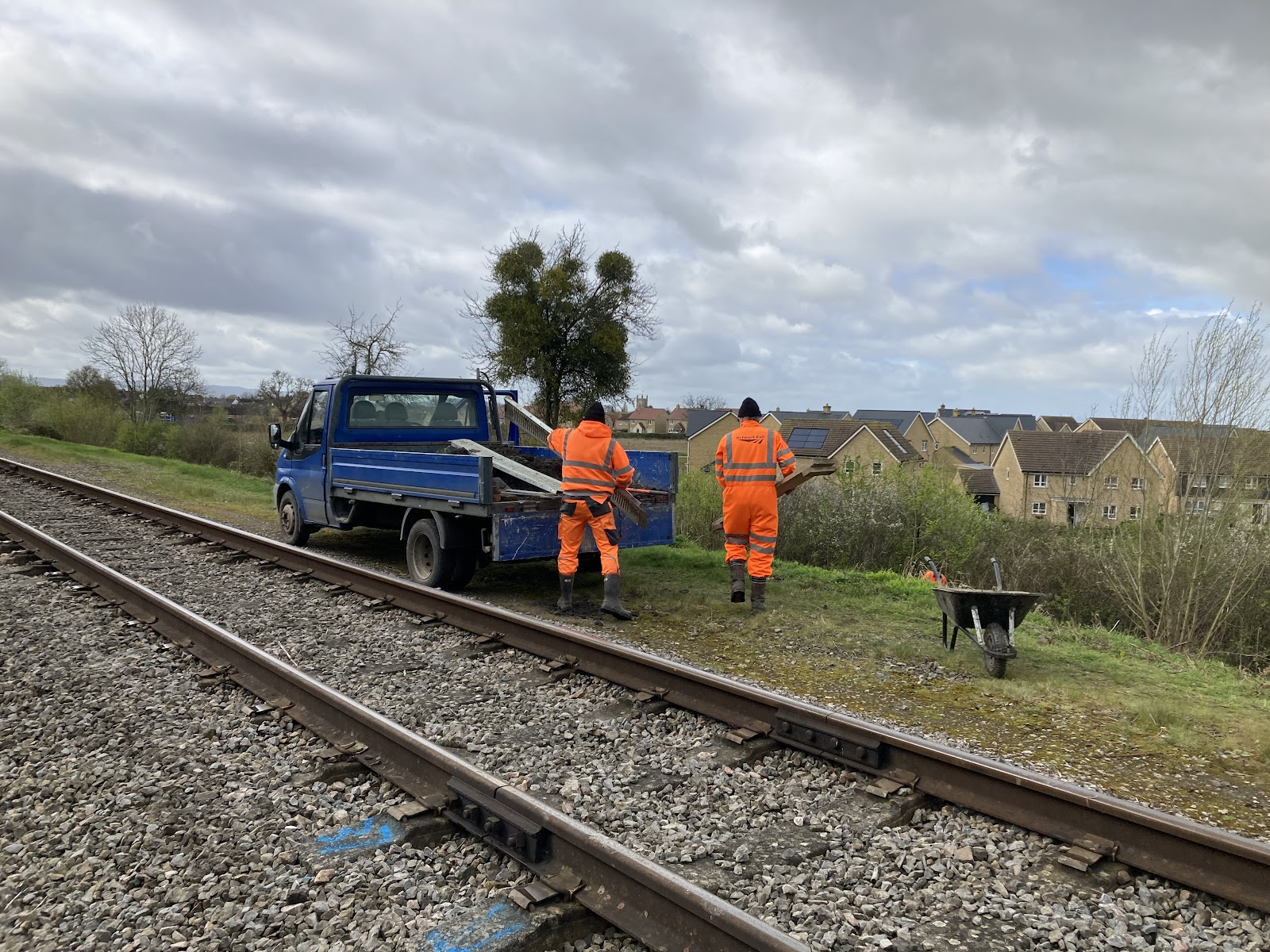Surprisingly for this wet spring, two of our working days in April were dry. At least, dry in terms of precipitation – however the ground conditions are far from dry. The last Thursday of April was more typical – and temperature wise more like February!
Thursday 11th April
A very good day - on two counts. Firstly it did not rain at all, secondly we achieved more than the planned tasks. Six of the team in attendance.
First task was to replace the spark plugs in the generator and the cement mixers - we expected to need the generator later.
Jonathan and Martin headed to Cheltenham - to collect an order of Postcrete from Travis Perkins. Also collected from a scaffolding contractor at Leckhampton was several length of old scaffold pole which had been donated. We will use these to construct safety markers for culvert and cross drain headwalls.
Stuart, Nigel, Dave and Andrew first went to Southam Lane bridge. The main task was to investigate the manhole by the side of the racecourse perimeter road which had been overflowing during Gold Cup week. We had expected to pump this out - but the water level had dropped naturally. This revealed the exit pipe, a 6" diameter blue plastic than runs down to the down side cess chamber. We rodded this out and also removed the silt from the bottom of the chamber. This reduced the standing water level even more. We used some tracer dye to confirm that both the larger diameter pipes that enter the chamber (on the right in picture below) run from the ditch alongside Southam Lane (south side uphill) - one of which flows well but the other is obstructed. As these are outside of railway land we did not attempt to rod them. We also cleared silt, debris and rubbish from the down side cess chamber - will come back later to fit an extended cover to prevent the rubbish accumulating.
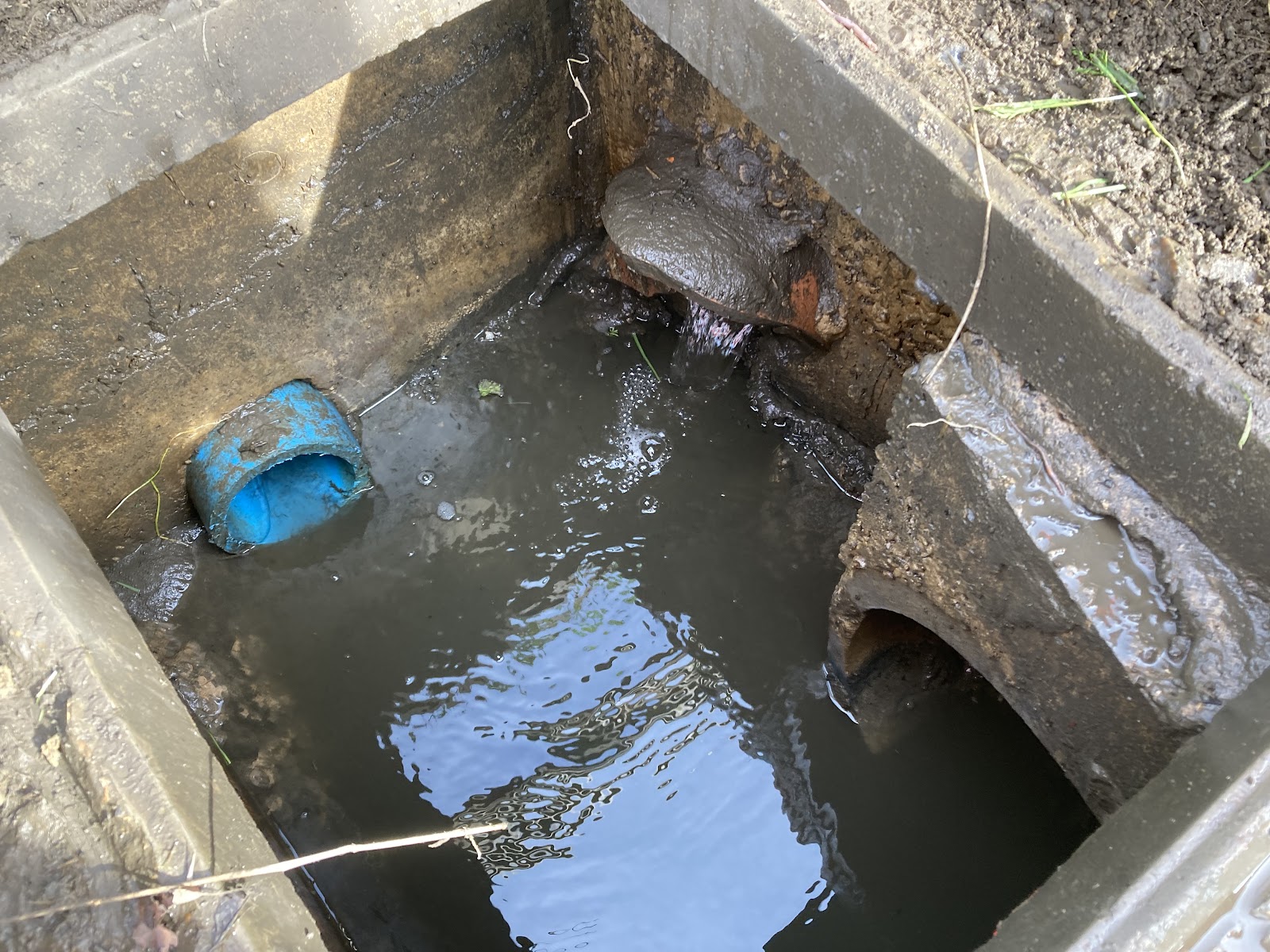 |
| The blue plastic pipe is the exit to the down side cess, whilst the two larger pipes on the right are the inlets from the roadside ditch on Southam Lane. |
 |
| As concrete lids become broken, we will be deploying metal grill lids. |
Whilst at Southam Lane we replaced two broken cess chamber lids on the up side between the bridge and the RDA crossing. The replacement lids are the metal grills; as we have no spare reinforced concrete lids which fit the concrete chamber rings.
Then after coffee break, all six of us went to investigate the security barrier at the south portal of Hunting Butts tunnel. One of the sheet piles was loose. We developed a plan to fix it - and determined that we had sufficient manpower, tools and materials to execute it after lunch. This involved some of the bags of just collected Postcrete to cement in lengths of rail to wedge the sheet piles. Hopefully this will keep the trespassers out - for a while at least!
 |
| Stuart and Dave cementing the footings of the security fence at the south portal of Hunting Butts tunnel. |
Wildlife report: We noted a large spotted slug in one of the cess chambers, probably a leopard slug or Limax maximus. Skylarks heard and seen at Hunting Butts. Bluebells in flower on the cutting sides at Racecourse Station.
Thursday 18th April
Surprisingly another dry day - so we were able progress with some bridge work that required no rain. Again, six of the team in attendance.
Roger, Dave and Martin spent the day working on the low mileage up side wing wall of the River Isbourne bridge. Most of the effort was in cutting some imperial solid bricks to triangular shapes; replacing those which broke when being removed or attempting a clean-up.
 |
| Roger and Martin progressing the Isbourne wing wall repair. [Photo by Dave] |
Jonathan worked on plant maintenance - giving the dumper and the telehandler a steam clean (courtesy of Halls); then greasing the dumper. The dumper was used to ferry mixed mortar from Winchcombe yard to the Isbourne bridge. Jonathan also started a bit of silt and debris removal from the Isbourne - but more is required when the level drops a bit more.
Ian and Andrew first went to Stanton Aqueduct. We used two tubes of mastic in the cracks between the down side brick/concrete inlet through and the concrete abutment. These cracks had widened since repointing last year; also some of the flaunching in the inlet had come away and there were brambles growing in the inlet. Underneath the 300mm pipe was some shallow water - so unable to put mastic there. From the ground conditions on the down side cutting underneath the trough, it appears that there is only minor leakage from the inlet.
 |
| Mastic filling the cracks between the inlet trough and the concrete abutment, high mileage side ... |
 |
| ... and low mileage side. |
We checked the slip marker posts under the downside of the aqueduct. The two directly under the aqueduct have a very slight downwards lean; the rest are all still in line and upright.
After lunch we prepared some more lengths of bridge rail for milepost uprights - we now have 6 ready to go. Also we made up a culvert headwall safety marker from some of the old scaffold poles. This is destined for 37F.
Wildlife report: birds this week. A wren and chiffchaffs at Stanton and a flock of noisy sparrows at Winchcombe.
Thursday 25th April
For the first time for quite a few months all nine members of the team attended. Hence we spilt into three groups of three.
Nigel, Dave and Roger continued with the rebuilt of the low mileage up side wing wall of the the River Isbourne bridge. Good progress was made until a very heavy rain shower just after lunch made it too wet to lay mortar and too slippery to work safely. Four more coping stones remain to be replaced.
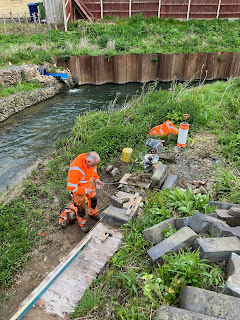 |
| Roger evaluates the next replacement for the Isbourne wing wall. [Photo by Dave] |
Jonathan, Martin and Stuart, with the mini excavator, went to Gotherington Yard. The task of the day being to move some of the spoil that had come from Broadway to the low mileage side of the inlet of culvert 33B by the road side fence; also to fix the yard gate. The pile of mainly clay from Broadway is starting to dry out - or at least the top foot or so. As the arm of the excavator is not that long; quite a bit of the moving took two steps. The roadside fence was dismantled to enable the arm to reach behind the outflow headwall of the under road part of the culvert. Another job where the heavy early afternoon shower hindered progress.
 |
| Stuart and Martin begin to replace the roadside fence at Gotherington Yard. It was removed to enable the excavator to access the low mileage side of culvert 33B to level our the clay infill. |
Polly (welcome back!), Ian and Andrew completed the fabrication of the first two headwall safety markers - three lengths of old scaffold poles bolted together. We then went to Bishops Cleeve to install these on both headwalls of cross drain 37F. No excuse for robo flail operators to miss these structure now! (At least a dozen other culverts/cross drains will be similarly marked).
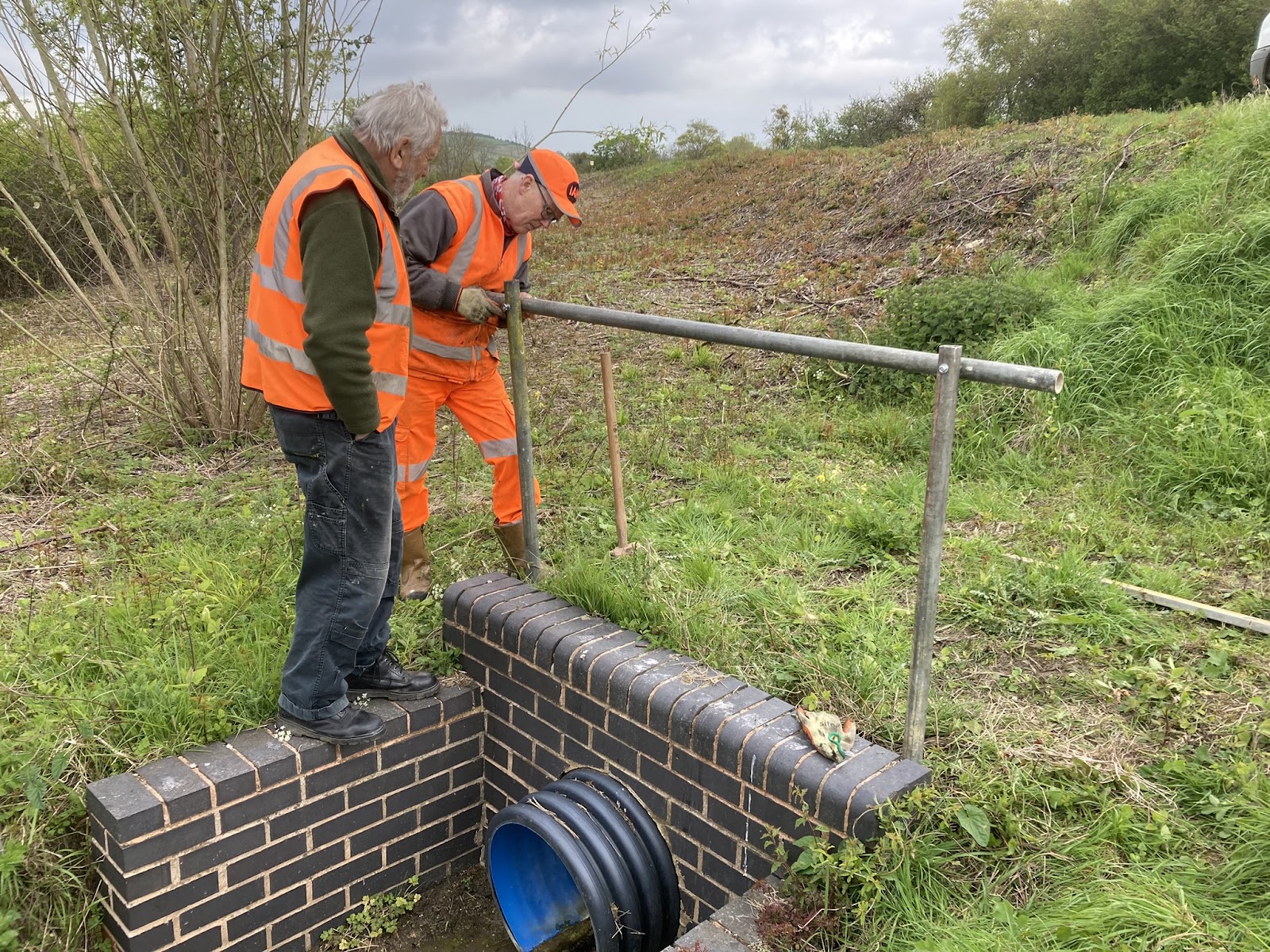 |
| Polly and Ian fix the safety marker to the outlet (up side) of cross drain 37F. |
 |
| 37F inlet (down side) also now has a safety marker rail. |
Then along to cross drain 37D to attend to some repointing of joints in the up side exit headwall and wingwalls. Next a look at the upside exit of 37A where three concrete slabs in the low mileage wall are displaced. We noted that the concrete base of the exit channel is cracked; so decided that the best approach here is a more substantial rebuilt when the flow of water is less. Finally we joined the Gotherington Yard team to make a minor brickwork repair to culvert 33B and after a quick trip back to Winchcombe to collect long nails to assist with replacing the roadside fence.
Wildlife report: Lots of snails at Gotherington Yard. Also noted buzzards being mobbed by the crows in the up side field. More blossom on the pear trees between Bishops Cleeve and Gotherington; plus several clumps of yellow primula in full flower. These probably are Primula veris, cowslip.








